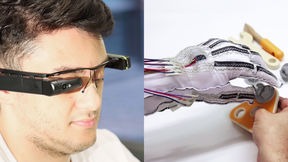Gesture recognition technology shrinks to micro size

The use of augmented reality (AR) applications and wearable electronics is constantly increasing in the industry. For instance, smart glasses can show an employee real-time instructions on how to assemble a device or help find parts that need service. Smart textiles based on sensor technology, such as smart gloves, can convert physical movements into virtual equivalents and quite literally guide the employee by the hand.
The smart glove must be able to accurately detect hand and finger movements and grip force. This is often done using deep neural networks, machine learning methods that mimic the function of the human brain and traditionally require a lot of computational power. Researchers at Aalto University have collaborated with HitSeed, a company that specialises in intelligent sensor technology, to develop gesture recognition that can be used on even fingertip-sized microcontrollers.
‘Usually, sensor data collected by gloves needs to be sent over a network to a computer that processes it and sends the information back. The deep learning-based gesture recognition algorithms we have developed are so lightweight that they can do the same locally in an embedded system like smart gloves,’ says Yu Xiao, a researcher at Aalto University who is the leader of a research group that specialises in wearable systems development.
This means that the devices can be used anywhere, without the need for internet connection or an external computer. The information can be transferred between the smart gloves and AR glasses using the Bluetooth Low Energy network.
The technology could be used in a variety of embedded systems for sensor data in the future.
’We can apply the developed technology for several measurement types like keeping separate counts for multiple gestures, for measuring motion improvements in physiotherapy or for detecting the state of multiple machines running based on a vibration or sound spectrum,’ says HitSeed CTO Pertti Kasanen.
‘Smart sensors and augmented reality and virtual reality applications have endless opportunities in industry, healthcare and education,’ Xiao says.
The researchers used HitSeed’s fingertip-sized Sensor Computer, which supports Google’s Tensor Flow Lite software library, to run convolutional neural networks (CNNs) on smart gloves. CNN is a specialised type of neural network which is often used for image classification. A CNN is made up of neurons that have learnable weights and biases. As a next step, the system will be extended to support local execution of long short-term memory (LSTM), which is commonly used for processing entire sequences of data such as speech and video.
The research project received €100,000 seed funding from the European Union's Horizon 2020 ATTRACT project, which supports collaboration between research institutes and companies to develop technologies that change society. Next, researchers will seek partners for research aimed at commercialising the technology.
More information about the technology (pdf).
Contact
Professor Yu Xiao
Department of Communications and Networking
[email protected]
Pertti Kasanen
Partner, CTO/HitSeed
[email protected]
- Published:
- Updated:
Read more news

What makes nature restorative? Aalto University researchers explore Finnish forests and Japanese gardens
Biodiversity is central to the restorative power of Finnish forests.
New technology brings immersive audio to everyone’s pockets
A new type of sound recording technology allows recording of immersive soundscapes with ordinary microphones and an inexpensive accessory
Funding for a democratic transition to sustainability
Three projects from Aalto University are among the recipients. The Nessling Foundation's grants aim to advance the implementation of sustainability transitions in the context of democracy, the EU, and nature conservation areas.